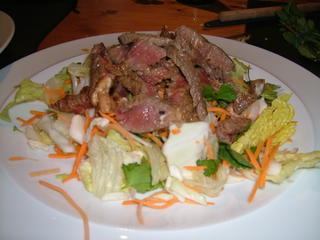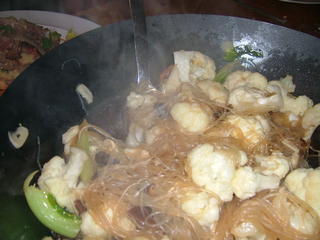One of the things the area I live in really lacks is a good fishmonger. As a result, raw prawns with the shells still on are very hard to find, so whenever I spot them in the supermarket I grab about six bags and freeze them.
Why do I want to keep the shells on, you ask? It’s perfectly simple; cooked like this, the shells not only add rich flavour to the flesh of the prawns, but become delicious in their own right. They’re a little crunchy, a little chewy, and extremely tasty, so don’t bother peeling your prawn – eat it shell and all. I wish my prawns has also had heads (ask any Chinese person; the head is the best bit), but head-on raw prawns are increasingly hard to find these days.
I was planning on barbecuing these little guys, but the summer of torrential rain shows no signs of abating, and I’ve barely been able to use the barbecue at all this year. If the weather’s this bad where you are, put the prawns under the conventional grill. Lucky readers living where there’s sunshine and enough warmth to eat outdoors should drag out the barbecue for this one.
To cook enough prawns for a very substantial meal for two (or a sensibly sized meal for three) you’ll need:
500g raw, defrosted prawns with the shells on (raw frozen prawns will be blue-grey, not pink)
4 tablespoons light soya sauce
2 tablespoons sweet dark soya sauce (kejap manis)
4 tablespoons oyster sauce
2 tablespoons Thai fish sauce
2 tablespoons honey
1 bird’s eye chilli
1 head garlic
1 large handful coriander, chopped
Use a sharp knife to butterfly the prawns – make a slit between the prawn’s legs from the base of the tail to the place where the head was, slicing through the flesh, but not through the shell on the prawn’s back. Flatten the prawns out with your hand. Cutting the prawns like this will maximise the surface area, helping them to take up the flavour of the marinade.
Mince all the cloves from the head of garlic with a large, sharp knife. (This is very easy – just lay the cloves on a chopping board and, holding the knife at the tip and the hilt and using a rocking motion, ‘walk’ the blade up and down the board for about five minutes. You’ll find the garlic is chopped finely and evenly. It’s probably not best to eat this immediately before going on a date.) Chop the chilli finely and mix it and the garlic with all the liquid ingredients. Stir the marinade mixture well to blend everything, then tip the prawns in, stirring to make sure they’re well covered. Refrigerate for 40 minutes. This is quite a penetrating marinade, so don’t leave the prawns for more than an hour or they will taste too strong.
When you are ready to cook the prawns, reserve the marinade and place them on a barbecue or under a very hot grill for three or four minutes per side, until they turn pink and the skins start to caramelise a little. Meanwhile, bring the marinade to a strong boil for about thirty seconds. Drizzle a little of the wonderfully garlicky cooked marinade over the prawns to serve, and dress with plenty of fresh coriander…and remember to eat those delicious shells!




